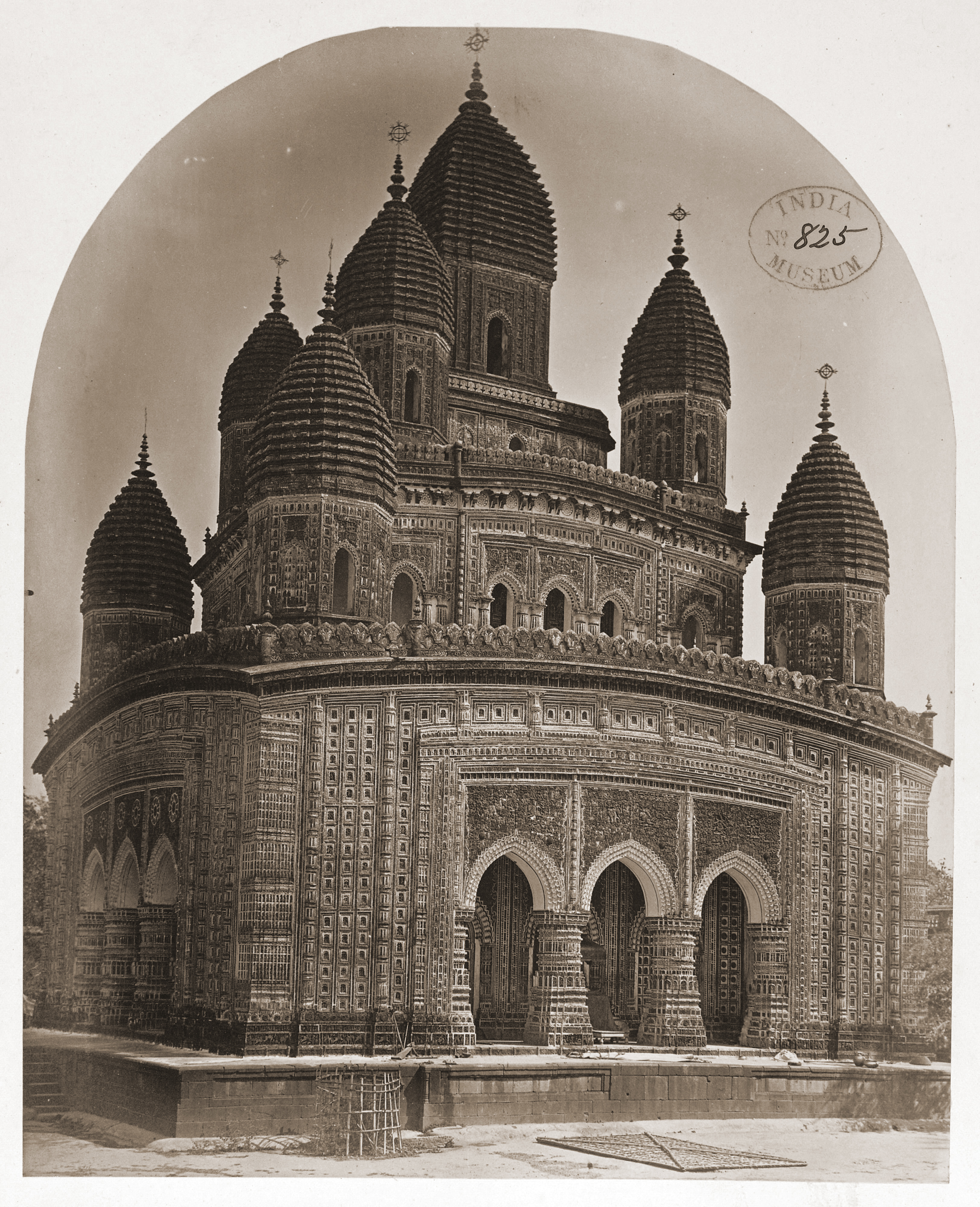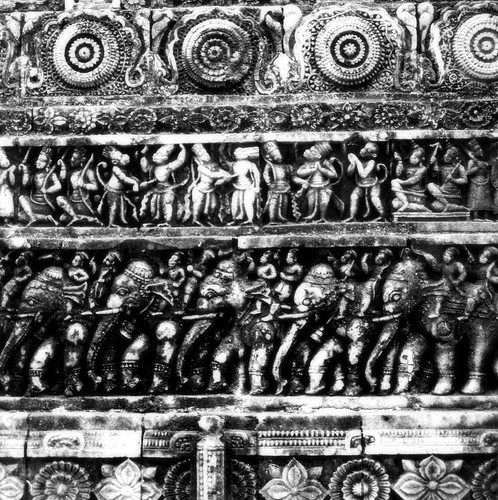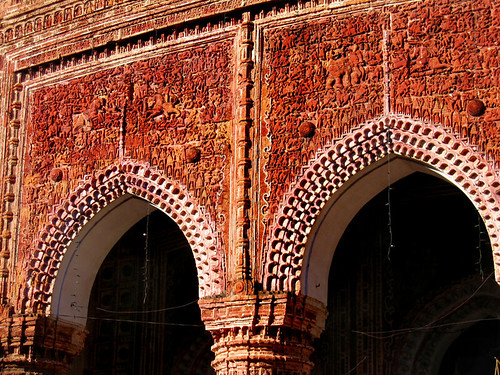Kantanagar Temple : The Exuberance of Terracotta Art
Sundarpur: Kaharole: Dinajpur: Bangladesh
 |
| 1870's from Wiki |
Introduction
Kantanagar Temple [also known as Kantaji or kantajir Mandir or sporadically titled as Kanta-jiw(jew) Temple], an eighteenth century brick temple situated in the peaceful island hamlet of Kantanagar (Kantanagar), in Sundarpur Union; about 12 miles north of Dinajpur town, and about a mile west of Dinajpur-Tetulia highway across the Dhepa river.It has gained eminence as an outstanding monument in Bengal for its fabulous terracotta embellishment. A breath taking religious edifice belonging to the late medieval period, exhibits the exuberance of terracotta art at its best in Bangladesh. This nava-ratna or 'nine spired' Hindu temple, now stripped off its original nine spires atop its corners during the devastating earthquake of 1897.This temple is listed as world cultural heritage site by UNESCO.
Construction Period
The confusion about the date of its construction can be settled from the record of a chronogram in the Sanskrit stone inscription, fixed on the northeast corner plinth of the temple. It records that Maharaja Prannath of Dinajpur began its construction about 1722. Bangladesh Archeology Department stated as,"Maharaja Pran Nath built it in 1752" in their website.
 |
| From Banglapedia |
 |
| Department of Archeology Bangladesh |
We already know that it was originally a Navaratna (nine- towered) temple, which are now ruined. Every inch of its surface is lavishly decorated with different scenes as described in the two Hindu Great Epics, various Hindu divinities, and contemporary social life and floral cum geometric motifs.
Temple rose in three receding terraces and was crowned with nine ornamental spires or ratnas (jewels) on the corner of the three terraces which imparted to it an appearance of a huge ratha or an ornate chariot resting on a high plinth. It was provided with arched openings on all four sides in order to enable devotees to see the deity enshrined inside from all directions.
Architect and Base Plan
The 52´-0´´ square temple stands in the centre of an oblong court (240´×120´) enclosed by a pilgrim shed with a corrugated tin roof. Its main fabric pivots around a nuclear square cell (10´-3´´), shooting up to a height of about 50´ above its 3´-3´´ high plinth of stone, believed to have been quarried from the ancient ruins of Bannagar near Gangarampur in Dinajpur. Three other square outer shells in graded heights have been added to it, as much to variegate the plan as to strengthen the central cella which carry atop a massive tower. The other eight ornamental towers, now missing, occupied the eight roof corners of the lower two stories. The curved cornice of the ground floor, sharply drooping at the corners, rise in the middle to a height of 25´-0´´ from the plinth, while that of the first floor rises to 15´ and that of the second floor to 6´-6´´. There are small square cells at each of the four corners of the ground and first floors for supporting the heavy load of the ornate octagonal corner towers above. The temple accommodates four rectangular corridors on the ground floor around the prayer chamber measuring 30´-8´´×5´-0´´ and 15´-6´´×4´-4´´. On the ground floor, there are three multi- cusped arched entrances on each side, each separated by two richly decorated brick pillars. The number of arched doorways in the ground floor disposed in its four shells is 21; that of the first floor is 27. The reduced second floor has only three entrance doors and three windows. A narrow strip of staircase, merely 2´-3´´ wide, built into the western second corridor, winds up through its dark passage to the first, second, and third stories.
A small derelict single spired temple, now overgrown with rank vegetation, stands about one hundred yards north of the main temple beyond the pilgrim shed, which is believed to have been erected by Maharaja Prannath in 1704 where he initially installed the Krsna icon, brought from Brndaban. The icon was later transferred to the 'nava ratna' temple when completed. It is now an abandoned shrine. It is a 16-sided temple rising to a height of about 40´ and provided with a multi-cusped arched entrance on the south.
Terracotta Decoration
Every available inch of its wall surface from the base to the crest of its three stories, both inside and out, pulsates with an amazing profusion of figured and floral art in unbroken succession. The vast array of subject matter include the stories of the Mahabharata and the Ramayana, the exploits of Krishna, and a series of extremely fascinating contemporary social scenes depicting the favorite pastimes of the landed aristocracy.
The astonishing profusion, delicacy of modeling, and the beauty of its carefully integrated friezes have seldom been surpassed by any mural art of its kind in Bengal. However, even in its bewildering abundance of diverse motifs, one can observe a carefully arranged thematic scheme in the composition of subject matters at different levels and spaces on the temple wall.
In general pattern of terracotta decoration of the temple's outer walls, the lowest four basal panels, running parallel across the four faces, depict from bottom upward, immediately above the plinth: (a) a recurring floral motif, consisting of full blown rosettes alternated with a four-foiled foliate pattern; (b) the second frieze portrays contemporary social scenes and the hunting parties of the landed nobility; (c) the third parallel panel above depicts an intricately designed series of full blown rosettes.
The second register depicts animated hunting scenes of wild games, royal processions of elephants, horses, camels, and dainty ox-carts of the nobility with their retainers in Mughal dress and arms. The richly caparisoned majestic elephants and splendid stallions, their chariot and harness are vividly delineated; corpulent zamindars are seen squatting in their gilded palanquins puffing from luxurious hukkas with long sinuous pipes. Still other panels portray river cruises on long slim boats crowded with revellers; squads of soldiers often wearing European dress are also shown marching with drawn swords and even muskets.
Mythological scenes on the third register depict the nativity of Krsna; the demon King Kangsa; successive attempts to kill the infant Krsna; Krsna's killing of the Putana ogress and the Bakasura or crane-demon; the lifting of Govardhana mountain, the killing of Keshi; the quelling of the snake-demon, Kaliya, and Krsna's pleasure ride on a long slim boat with revellers. The south face of the temple also presents stories from the Ramayana in a somewhat confused sequence. Ramayana stories continue on the east face. Here the exile of Ramachandra, Sita, and Laksmana in the Panchavati forest; Laksmana's striking off the nose of Shurpanakha; the abduction of Sita by Ravana from Dandakaranya; Jatayu's futile attempt to obstruct the chariot of Ravana; the captivity of Sita in Ashoka Forest; the fight between Bali and Sugriva with their monkey followers for the throne of Kiskindhya; Ramachandra's sapta tala veda and Sugriva with his monkey followers and their palaver with Ramachandra are shown in striking details.
The north face predominantly portrays scenes of Krsna and Balarama. Thus Krsna's various marriages and cowgirls carrying milk and curd pots in shika (string bags) suspended from pole etc are shown. In the second register an interesting European battle ship is depicted in great details with soldiers and a cannon.
The entire western face of the third register depicts various episodes from the Krsna legend, ending in the slaying of Kangsa, the demon king of Mathura. It includes the annihilation of Kuvalayapida, the monstrous killer elephant of Kangsa; and Radha's fainting fits on her failing to dissuade Krsna from participating in Kangsa's sport tournament in Mathura. Of particular interest is a group of cowherds carrying milk and butter in string bags, suspended from a pole on shoulder, which is still a familiar scene in rural Bengal.
The elaborate panels over the spandrels of multi-cusped arches exhibit animated battle scenes from the great epics and also rasa-mandala, with dancing Radha-Krishna couple within circles, and a host of accessory figures. The spirited battle scenes of Kurukshetra and Lanka are depicted with great vitality and invention by the folk artists. They represent a highly sophisticated mature art with a very carefully integrated scheme of decoration.
Regular Activities
The regular religious and ritual activities are as follows:
People perform puja in the temple regularly thrice daily, during sunrise, midday and sunset. A few rituals like jhapar(first haircut of baby), Annaprashan (first rice feeding of baby), marriage feast and shradha(ritual after death). Beside the temple authorities arrange religious ceremonies and festival in order to rise money from the devotee for the maintenance of the temple. These are Snanyatra, Dolyatra, Rasmela, and Hari-shabha or Harijapa.
How to Reach There
One can start his journey for the monument from Dinajpur town or Sayedpur Airport by any kind of motorized vehicle. If he is a biker, than there is no problem. I suggest travelers to hire a rickshaw van of take a ride by 'Nosimon' from the place called 'Das Mile*, which means 10 miles' upto 'Baro Mile*, which means 12 miles' boat point.
It may take 10-20 Taka person for ride. After Reaching Baro Mile point cross the Dhepa River. Travelers will find boatman waiting for crossing the silty river to Kantanagar hamlet. Than just little walk will lead the travelers to the premises of the temple. The temple was originally built on the west bank of the Dhepa river, due to that earthquake and flash flood the river changed it course and shifted to the east. Enjoy.
*These places are named base on the distance from Dinajpur Town.
Temple rose in three receding terraces and was crowned with nine ornamental spires or ratnas (jewels) on the corner of the three terraces which imparted to it an appearance of a huge ratha or an ornate chariot resting on a high plinth. It was provided with arched openings on all four sides in order to enable devotees to see the deity enshrined inside from all directions.
Architect and Base Plan
The 52´-0´´ square temple stands in the centre of an oblong court (240´×120´) enclosed by a pilgrim shed with a corrugated tin roof. Its main fabric pivots around a nuclear square cell (10´-3´´), shooting up to a height of about 50´ above its 3´-3´´ high plinth of stone, believed to have been quarried from the ancient ruins of Bannagar near Gangarampur in Dinajpur. Three other square outer shells in graded heights have been added to it, as much to variegate the plan as to strengthen the central cella which carry atop a massive tower. The other eight ornamental towers, now missing, occupied the eight roof corners of the lower two stories. The curved cornice of the ground floor, sharply drooping at the corners, rise in the middle to a height of 25´-0´´ from the plinth, while that of the first floor rises to 15´ and that of the second floor to 6´-6´´. There are small square cells at each of the four corners of the ground and first floors for supporting the heavy load of the ornate octagonal corner towers above. The temple accommodates four rectangular corridors on the ground floor around the prayer chamber measuring 30´-8´´×5´-0´´ and 15´-6´´×4´-4´´. On the ground floor, there are three multi- cusped arched entrances on each side, each separated by two richly decorated brick pillars. The number of arched doorways in the ground floor disposed in its four shells is 21; that of the first floor is 27. The reduced second floor has only three entrance doors and three windows. A narrow strip of staircase, merely 2´-3´´ wide, built into the western second corridor, winds up through its dark passage to the first, second, and third stories.
 |
| Edited From Banglapeida |
Terracotta Decoration
Every available inch of its wall surface from the base to the crest of its three stories, both inside and out, pulsates with an amazing profusion of figured and floral art in unbroken succession. The vast array of subject matter include the stories of the Mahabharata and the Ramayana, the exploits of Krishna, and a series of extremely fascinating contemporary social scenes depicting the favorite pastimes of the landed aristocracy.
 |
| Credit: bengal*foam's from Flickr |
 |
| Credit: bengal*foam's from Flickr |
 |
| Credit: bengal*foam's from Flickr |
Mythological scenes on the third register depict the nativity of Krsna; the demon King Kangsa; successive attempts to kill the infant Krsna; Krsna's killing of the Putana ogress and the Bakasura or crane-demon; the lifting of Govardhana mountain, the killing of Keshi; the quelling of the snake-demon, Kaliya, and Krsna's pleasure ride on a long slim boat with revellers. The south face of the temple also presents stories from the Ramayana in a somewhat confused sequence. Ramayana stories continue on the east face. Here the exile of Ramachandra, Sita, and Laksmana in the Panchavati forest; Laksmana's striking off the nose of Shurpanakha; the abduction of Sita by Ravana from Dandakaranya; Jatayu's futile attempt to obstruct the chariot of Ravana; the captivity of Sita in Ashoka Forest; the fight between Bali and Sugriva with their monkey followers for the throne of Kiskindhya; Ramachandra's sapta tala veda and Sugriva with his monkey followers and their palaver with Ramachandra are shown in striking details.
The north face predominantly portrays scenes of Krsna and Balarama. Thus Krsna's various marriages and cowgirls carrying milk and curd pots in shika (string bags) suspended from pole etc are shown. In the second register an interesting European battle ship is depicted in great details with soldiers and a cannon.
The entire western face of the third register depicts various episodes from the Krsna legend, ending in the slaying of Kangsa, the demon king of Mathura. It includes the annihilation of Kuvalayapida, the monstrous killer elephant of Kangsa; and Radha's fainting fits on her failing to dissuade Krsna from participating in Kangsa's sport tournament in Mathura. Of particular interest is a group of cowherds carrying milk and butter in string bags, suspended from a pole on shoulder, which is still a familiar scene in rural Bengal.
The elaborate panels over the spandrels of multi-cusped arches exhibit animated battle scenes from the great epics and also rasa-mandala, with dancing Radha-Krishna couple within circles, and a host of accessory figures. The spirited battle scenes of Kurukshetra and Lanka are depicted with great vitality and invention by the folk artists. They represent a highly sophisticated mature art with a very carefully integrated scheme of decoration.
Regular Activities
The regular religious and ritual activities are as follows:
People perform puja in the temple regularly thrice daily, during sunrise, midday and sunset. A few rituals like jhapar(first haircut of baby), Annaprashan (first rice feeding of baby), marriage feast and shradha(ritual after death). Beside the temple authorities arrange religious ceremonies and festival in order to rise money from the devotee for the maintenance of the temple. These are Snanyatra, Dolyatra, Rasmela, and Hari-shabha or Harijapa.
 |
| In postage stamp of Bangladesh |
One can start his journey for the monument from Dinajpur town or Sayedpur Airport by any kind of motorized vehicle. If he is a biker, than there is no problem. I suggest travelers to hire a rickshaw van of take a ride by 'Nosimon' from the place called 'Das Mile*, which means 10 miles' upto 'Baro Mile*, which means 12 miles' boat point.
 |
| Travel route from Dasmile to Temple in Google Map[CLICK FOR LARGE VIEW] |
*These places are named base on the distance from Dinajpur Town.
--------------------------------------------
This post is compiled based on the Main Article from Banglapedia | More reading in Wikipedia | Image Gallery in Wikimedia Commons(a must see gallery)
This post is compiled based on the Main Article from Banglapedia | More reading in Wikipedia | Image Gallery in Wikimedia Commons(a must see gallery)
Ahmed Sharif's Pixes | In Google Earth

7 comments:
WOW! That's incredible!
Hugs.
thank for your visit on my blog, your page is very interesting and I congratulate you for your good work ! :))
Bye**
thats a one beautiful place to see.
Thanks to Teca, Mahon and Sports fan to see and read this post. Stay well all of you. Take care. every comments is always inspirational for me.
As you know, I don't always have the time to reply to all posts, but in this case I just had too. These buildings are just great, and would have taken a loooong time to build with all those details!
Interesting post as usual, Faysal!
Regards, Kite.
one most exciting place, this should be a heritage sight.
I love terracotta work, and this is exquisite!
Post a Comment